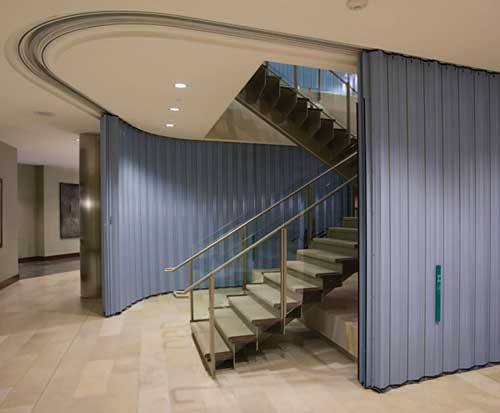Horizontal Sliding Fire Doors: Catalyst for Architectural Versatility
Learning Objectives:
- Identify and describe the functioning components of sliding fire-doors.
- Assess and discuss the design implications of specifying sliding fire-doors.
- Reference the building and fire codes that regulate sliding fire-doors.
Credits:
Since successfully passing Underwriters Laboratories (UL) fire-rating tests in 1977, self-closing horizontal sliding accordion type doors have long been sought as a solution to meeting fire requirements in certain applications. But twentieth century codes have not always accepted them as a complete solution for meeting fire and building code egress regulations. Design professionals were often required to specify standard wood or steel-framed hinged swinging doors to serve as emergency exits and to separate internal spaces. Since 2000, however, significant code changes have greatly expanded the use of horizontal sliding door systems. Today, these systems are universally accepted as meeting both fire and building code regulations in virtually any application. (The exceptions are certain applications categorized as Group H occupancies that typically include the storage of flammable and toxic materials.)
Yet many design professionals remain unaware of these code changes and the significant architectural possibilities resulting from their across-the-board code acceptance ? and the implications of incorporating sliding door systems early in the design stages.
Sliding door systems play an increasingly key design role where there is a need to have openings that exceed the 4 or 8 feet provided by conventional fire rated single or double swing doors. Moreover, free from the limitations of rectilinear footprints, architects are now able to design fire-rated extended spans and curved openings for an almost endless number of applications. There are many application examples in the U.S. and abroad. Installed in a multitude of building types, they are found in schools, churches, high rise office buildings, casinos, airports, senior living facilities, health care facilities, shopping malls, hotels, public transit and museums ? often at lower costs than for other solutions. With an increased focus on building security since 9/11, government offices, embassies, schools and courthouses are also increasingly turning to sliding door systems as protection in emergency situations.
 |
Curved sliding fire doors protect multi-story stairways and eliminate the need for costly smoke removal systems. Photo courtesy of John Durant |
Â
From the $2.4 billion Venetian Macao, anchor luxury hotel on the Cotai strip under construction in Macao, China to Frank O. Gehry's Guggenheim museum in Bilbao, Spain, sliding door systems also offer an innovative solution to the code constraints of creating iconic and unique architecture.
Sliding door systems provide an eminently practical means for moving people through an unobstructed exiting system of a building quickly. Repeated testing for use by occupants with disabilities and in wheelchairs has demonstrated that the sliding door system is far more effective when evacuating people from a building than a side-hinged or swing door. Swing doors clearly present user problems in building emergency situations, both for people in wheelchairs and on foot, particularly in crowded situations and when fire and rescue personnel are coming through the door from the opposite direction. Manufacturers have researched and developed sensors and precision microprocessor technology that opens and closes the sliding door with ease. In an emergency, a person with disabilities or in a wheelchair touches the fire exit hardware; the door opens to a preset width, allowing the person to egress and then recloses protecting the opening. "The fire-rated horizontal sliding door is the best way to move people through fire barriers during any type of building emergency ? whether or not they have a disability," says Edwina Juillet, co-founder, National Task Force on Fire and Life Safety for People with Disabilities.









